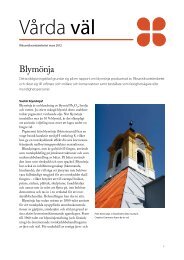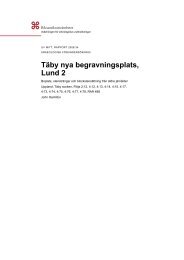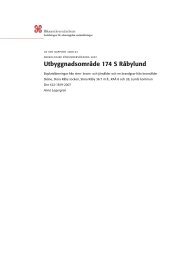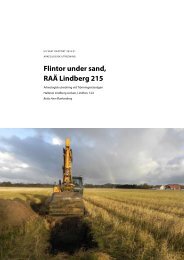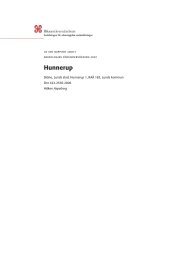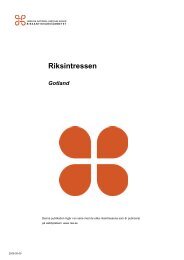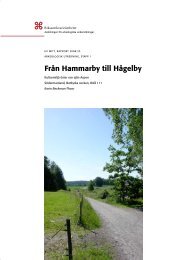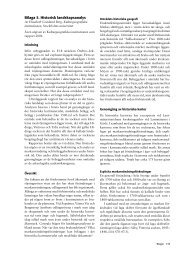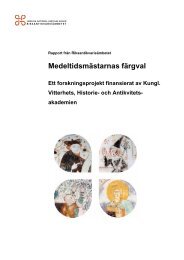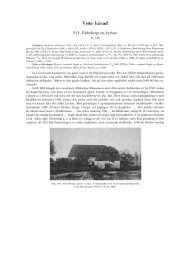framework for implementation of the ELC in Sweden
framework for implementation of the ELC in Sweden
framework for implementation of the ELC in Sweden
You also want an ePaper? Increase the reach of your titles
YUMPU automatically turns print PDFs into web optimized ePapers that Google loves.
Report on Government AssignmentFramework <strong>for</strong> Implementation<strong>of</strong> <strong>the</strong> European LandscapeConventionA proposal
Framework <strong>for</strong> Implementation <strong>of</strong> <strong>the</strong> European Landscape Convention 2© 2011 Swedish National Heritage BoardBox 5405S-114 84 Stockholmwww.raa.seriksant@raa.se
Framework <strong>for</strong> Implementation <strong>of</strong> <strong>the</strong> European Landscape Convention 3Content1. Background2. Summary3. The assignment4. Works process5. Proposal6. Comments <strong>for</strong> <strong>the</strong> report
Framework <strong>for</strong> Implementation <strong>of</strong> <strong>the</strong> European Landscape Convention 4BackgroundThe Swedish National Heritage Board serves as <strong>Sweden</strong>'s central adm<strong>in</strong>istrative agency <strong>in</strong><strong>the</strong> field <strong>of</strong> heritage and <strong>the</strong> historic environment. It works under <strong>the</strong> auspices <strong>of</strong> <strong>the</strong> M<strong>in</strong>istry<strong>of</strong> Culture.S<strong>in</strong>ce 2006 The Heritage Board has been advis<strong>in</strong>g <strong>the</strong> Swedish Government on <strong>the</strong><strong>implementation</strong> <strong>of</strong> <strong>the</strong> European Landscape Convention. Dur<strong>in</strong>g 2006-2008 a majorGovernment assignment was accomplished <strong>in</strong> order to outl<strong>in</strong>e <strong>the</strong> scope <strong>of</strong> a Swedish<strong>implementation</strong> <strong>of</strong> <strong>the</strong> Convention. In 2008 an additional assignment was undertaken toassess <strong>the</strong> legislative preconditions at <strong>the</strong> prospect <strong>of</strong> ratification. Under <strong>the</strong> supervision <strong>of</strong><strong>the</strong> M<strong>in</strong>istry <strong>of</strong> Culture, both <strong>the</strong>se proposal were subject to consultation <strong>in</strong> 2009.In November 2010 <strong>the</strong> Heritage Board was tasked with a new assignment to <strong>in</strong>itiate <strong>the</strong><strong>implementation</strong> <strong>of</strong> <strong>the</strong> European Landscape Convention <strong>in</strong> <strong>Sweden</strong>. The expected outcome<strong>of</strong> this assignment was a draft proposal <strong>for</strong> a <strong>framework</strong> <strong>for</strong> <strong>implementation</strong> <strong>of</strong> <strong>the</strong> EuropeanLandscape Convention. The result is briefly presented <strong>in</strong> this report.SummaryAs a po<strong>in</strong>t <strong>of</strong> departure, <strong>the</strong> authorities concerned should be <strong>in</strong>dependently responsible <strong>for</strong>implement<strong>in</strong>g <strong>the</strong> provisions <strong>of</strong> <strong>the</strong> European Landscape Convention (<strong>ELC</strong>) with<strong>in</strong> <strong>the</strong>irrespective competences, as well as <strong>for</strong> follow-up and evaluation <strong>of</strong> <strong>the</strong> Convention.A group consist<strong>in</strong>g <strong>of</strong> <strong>the</strong> Swedish National Board <strong>of</strong> Hous<strong>in</strong>g, Build<strong>in</strong>g and Plann<strong>in</strong>g, <strong>the</strong>Swedish Environmental Protection Agency, <strong>the</strong> County Adm<strong>in</strong>istrative Boards, <strong>the</strong> SwedishBoard <strong>of</strong> Agriculture, <strong>the</strong> Swedish Board <strong>of</strong> Forestry, <strong>the</strong> Swedish Transport Adm<strong>in</strong>istration,<strong>the</strong> Swedish Agency <strong>for</strong> Economic and Regional Growth as well as <strong>the</strong> Swedish NationalHeritage Board are to be given jo<strong>in</strong>t, comprehensive coord<strong>in</strong>ation responsibilities <strong>for</strong> <strong>the</strong><strong>implementation</strong> <strong>of</strong> <strong>the</strong> Convention <strong>in</strong> <strong>Sweden</strong>.The Swedish National Heritage Board is proposed to be <strong>the</strong> chair <strong>of</strong> <strong>the</strong> group. The NationalHeritage Board is also given a coord<strong>in</strong>at<strong>in</strong>g role <strong>for</strong> periodic report<strong>in</strong>g to <strong>the</strong> Government
Framework <strong>for</strong> Implementation <strong>of</strong> <strong>the</strong> European Landscape Convention 5and to <strong>the</strong> Council <strong>of</strong> Europe. The responsibility and roles accord<strong>in</strong>g to <strong>the</strong> proposals aboveshould be en<strong>for</strong>ced through statutory <strong>in</strong>structions or specific assignments to each authority.Besides be<strong>in</strong>g a national, coord<strong>in</strong>at<strong>in</strong>g body, <strong>the</strong> responsibilities <strong>of</strong> <strong>the</strong> coord<strong>in</strong>ation groupshould <strong>in</strong>clude <strong>the</strong> follow<strong>in</strong>g specific tasks:• To prepare a national plat<strong>for</strong>m <strong>for</strong> <strong>the</strong> <strong>implementation</strong> <strong>of</strong> <strong>the</strong> <strong>ELC</strong>. The aim <strong>of</strong> thisdocument is to <strong>in</strong>terpret <strong>the</strong> provisions <strong>of</strong> <strong>the</strong> <strong>ELC</strong> with respect to Swedishconditions. The plat<strong>for</strong>m should address ma<strong>in</strong> challenges and stakeholdersconcerned, as well as provide a base <strong>for</strong> communicat<strong>in</strong>g <strong>the</strong> <strong>ELC</strong>• To organise recurrent meet<strong>in</strong>gs devoted to matters concern<strong>in</strong>g <strong>the</strong> <strong>ELC</strong> – anational landscape <strong>for</strong>um. The <strong>for</strong>um should function as an <strong>in</strong>spir<strong>in</strong>g and <strong>in</strong>clusivemeet<strong>in</strong>g place <strong>for</strong> a wide range <strong>of</strong> stakeholders, such as authorities, municipalities,NGO:s, universities and o<strong>the</strong>r relevant parties <strong>for</strong> <strong>in</strong><strong>for</strong>mation, development anddiscussions regard<strong>in</strong>g <strong>the</strong> application <strong>of</strong> <strong>the</strong> Convention.• To develop a common model <strong>for</strong> <strong>the</strong> follow-up <strong>of</strong> <strong>the</strong> convention, to be appliedwith<strong>in</strong> different policy areasThe Swedish National Heritage Board also proposes <strong>the</strong> County Adm<strong>in</strong>istrative Boards to beresponsible <strong>for</strong> coord<strong>in</strong>at<strong>in</strong>g <strong>the</strong> <strong>implementation</strong> <strong>of</strong> <strong>the</strong> <strong>ELC</strong> at a regional level.The assignmentIn November 2010 <strong>the</strong> Swedish National Heritage Board was commissioned by <strong>the</strong>Government to <strong>in</strong>itiate <strong>the</strong> <strong>implementation</strong> <strong>of</strong> <strong>the</strong> European Landscape Convention (<strong>ELC</strong>) <strong>in</strong><strong>Sweden</strong>. The Swedish National Heritage Board was <strong>in</strong>structed to undertake <strong>the</strong> assignment<strong>in</strong> collaboration with <strong>the</strong> County Adm<strong>in</strong>istrative Boards, <strong>the</strong> Swedish EnvironmentalProtection Agency, <strong>the</strong> Sami Parliament, <strong>the</strong> Swedish National Board <strong>of</strong> Hous<strong>in</strong>g, Build<strong>in</strong>gand Plann<strong>in</strong>g, <strong>the</strong> National Land Survey <strong>of</strong> <strong>Sweden</strong>, <strong>the</strong> Swedish National Board <strong>of</strong>Agriculture, <strong>the</strong> Swedish Board <strong>of</strong> Forestry, <strong>the</strong> Swedish Transport Adm<strong>in</strong>istration as well aso<strong>the</strong>r relevant agencies and stakeholders.The expected outcome <strong>of</strong> <strong>the</strong> assignment was a proposal regard<strong>in</strong>g which authority orauthorities should assume <strong>the</strong> coord<strong>in</strong>at<strong>in</strong>g responsibility <strong>for</strong> <strong>the</strong> Convention’s<strong>implementation</strong> with<strong>in</strong> different policy areas. Fur<strong>the</strong>rmore, <strong>the</strong> Government wanted <strong>the</strong>Swedish National Heritage Board to elaborate on <strong>the</strong> organisation and <strong>the</strong> models <strong>for</strong>collaboration regard<strong>in</strong>g <strong>the</strong> application <strong>of</strong> <strong>the</strong> Convention. The coord<strong>in</strong>ation responsibilitywas provisionally <strong>in</strong>dicated to <strong>in</strong>clude <strong>the</strong> follow<strong>in</strong>g tasks:
Framework <strong>for</strong> Implementation <strong>of</strong> <strong>the</strong> European Landscape Convention 6• to monitor and follow up <strong>the</strong> convention <strong>in</strong> <strong>Sweden</strong>,• to develop collaboration as well as communication and guidance with regards to<strong>the</strong> Convention,• to encourage participation <strong>of</strong> <strong>the</strong> civil society and <strong>the</strong> public <strong>in</strong> <strong>the</strong> <strong>implementation</strong>process,• to follow up and, if necessary, take new <strong>in</strong>itiatives regard<strong>in</strong>g protection,management and plann<strong>in</strong>g <strong>of</strong> landscapes accord<strong>in</strong>g to <strong>the</strong> Convention, and• to take <strong>in</strong>to account <strong>the</strong> current work on regional landscape strategies.The assignment was presented to <strong>the</strong> Government on 1 March 2011.Work processThe assignment has been carried out <strong>in</strong> collaboration with <strong>the</strong> authorities and organisations<strong>in</strong>dicated by <strong>the</strong> government as well as with o<strong>the</strong>r agencies and organisations which havepreviously participated <strong>in</strong> <strong>the</strong> Swedish National Heritage Board’s work on <strong>the</strong> LandscapeConvention. 1 A questionnaire with specific <strong>in</strong>quiries regard<strong>in</strong>g coord<strong>in</strong>ation responsibilityand organisation <strong>for</strong> <strong>the</strong> <strong>implementation</strong> <strong>of</strong> <strong>the</strong> <strong>ELC</strong> has been completed by <strong>the</strong> authoritiesand <strong>the</strong> result was compiled and discussed <strong>in</strong> a meet<strong>in</strong>g on 2 February 2011. Thequestionnaire’s responses and discussions have <strong>for</strong>med <strong>the</strong> basis <strong>for</strong> <strong>the</strong> Swedish NationalHeritage Board’s proposal.The proposalThe proposal is aim<strong>in</strong>g at sett<strong>in</strong>g up a <strong>for</strong>mal <strong>framework</strong> <strong>for</strong> <strong>the</strong> <strong>implementation</strong> <strong>of</strong> <strong>the</strong> <strong>ELC</strong> <strong>in</strong><strong>Sweden</strong>. The proposal deals with coord<strong>in</strong>ation, responsibility and organisation with regardsto <strong>the</strong> <strong>implementation</strong> <strong>in</strong> various relevant policy areas. The proposals also concern follow-upand evaluation <strong>of</strong> <strong>the</strong> Convention as well as important issues to be addressed <strong>in</strong> order to<strong>in</strong>itiate a comprehensive <strong>implementation</strong> process <strong>in</strong> <strong>Sweden</strong>.1 Besides <strong>the</strong> organisations <strong>in</strong>dicated by <strong>the</strong> Government, <strong>the</strong> Swedish National Heritage Board decidedto <strong>in</strong>vite <strong>the</strong> follow<strong>in</strong>g collaborators: The Swedish Energy Agency, <strong>the</strong> region <strong>of</strong> Västra Götaland, <strong>the</strong>Swedish Agency <strong>for</strong> Economic and Regional Growth, <strong>the</strong> municipality <strong>of</strong> Lund, <strong>the</strong> municipalities andcounty councils <strong>of</strong> <strong>Sweden</strong> and Region Skåne (<strong>the</strong> municipalities <strong>of</strong> Gotland and Hels<strong>in</strong>gborg decl<strong>in</strong>edto participate).
Framework <strong>for</strong> Implementation <strong>of</strong> <strong>the</strong> European Landscape Convention 7Coord<strong>in</strong>ation, responsibility and organisationConcerned authorities should be given an <strong>in</strong>dependent responsibility <strong>for</strong> <strong>the</strong><strong>implementation</strong> <strong>of</strong> <strong>the</strong> provisions <strong>of</strong> <strong>the</strong> Convention with<strong>in</strong> <strong>the</strong>ir respectivecompetences.The Swedish National Heritage Board believes that a shared responsibility betweenauthorities is <strong>the</strong> key to obta<strong>in</strong> successful ma<strong>in</strong>stream<strong>in</strong>g <strong>of</strong> <strong>the</strong> Convention <strong>in</strong>to a broadrange <strong>of</strong> policy areas. Only authorities operative with<strong>in</strong> a certa<strong>in</strong> sector have <strong>the</strong> ability t<strong>of</strong>ully assess <strong>the</strong> appropriate measures to be taken <strong>in</strong> order to make <strong>the</strong> Convention vitalwith<strong>in</strong> that policy context. The major part <strong>of</strong> <strong>the</strong> respond<strong>in</strong>g authorities has put <strong>for</strong>th <strong>the</strong> po<strong>in</strong>t<strong>of</strong> view that each authority should be responsible <strong>for</strong> <strong>the</strong> application <strong>of</strong> <strong>the</strong> Convention with<strong>in</strong>its field <strong>of</strong> competence. However, shared responsibility sets high demands <strong>for</strong> a jo<strong>in</strong>t vision<strong>for</strong> <strong>the</strong> <strong>in</strong>terpretation <strong>of</strong> <strong>the</strong> provisions <strong>of</strong> <strong>the</strong> Convention and <strong>for</strong> a uni<strong>for</strong>m application.A group <strong>of</strong> authorities should be given a jo<strong>in</strong>t, comprehensive responsibility <strong>for</strong>coord<strong>in</strong>at<strong>in</strong>g <strong>the</strong> <strong>implementation</strong> <strong>of</strong> <strong>the</strong> <strong>ELC</strong>. The group is proposed to <strong>in</strong>itiallycomprise <strong>the</strong> Swedish National Board <strong>of</strong> Hous<strong>in</strong>g, Build<strong>in</strong>g and Plann<strong>in</strong>g, <strong>the</strong>Swedish Environmental Protection Agency, <strong>the</strong> Swedish National Heritage Board, <strong>the</strong>County Adm<strong>in</strong>istrative Boards, <strong>the</strong> Swedish Board <strong>of</strong> Agriculture, <strong>the</strong> SwedishForestry Agency, <strong>the</strong> Swedish Transport Adm<strong>in</strong>istration and <strong>the</strong> Swedish Agency <strong>for</strong>Economic and Regional Growth.The establishment <strong>of</strong> such a cross-sectorial group is expected to streng<strong>the</strong>n a ma<strong>in</strong>streammode <strong>of</strong> <strong>implementation</strong> <strong>of</strong> <strong>the</strong> Convention <strong>in</strong>to a broad range <strong>of</strong> policy areas. With regardsto <strong>the</strong> current work, <strong>the</strong> constellation is also expected to be suitable <strong>for</strong> solv<strong>in</strong>g <strong>the</strong> tasksassociated with <strong>the</strong> early stage <strong>of</strong> <strong>the</strong> <strong>implementation</strong> process. However, <strong>the</strong> size <strong>of</strong> <strong>the</strong>group and <strong>the</strong> authorities <strong>in</strong>cluded must reflect current needs and challenges. Hence, <strong>the</strong>coord<strong>in</strong>ation group may be reduced or extended to relevant parties from a wider circle iffound to be necessary.The <strong>in</strong>clusion <strong>of</strong> <strong>the</strong> County Adm<strong>in</strong>istrative Boards <strong>in</strong>to <strong>the</strong> group makes an important l<strong>in</strong>kbetween <strong>the</strong> national and <strong>the</strong> regional level. The need <strong>for</strong> such a l<strong>in</strong>k has been stresseddur<strong>in</strong>g <strong>the</strong> consultation discussions.Society changes over time and so does <strong>the</strong> needs regard<strong>in</strong>g protection, management andplann<strong>in</strong>g <strong>of</strong> landscapes. New challenges will currently arise. Hence, an important task <strong>for</strong> <strong>the</strong>coord<strong>in</strong>ation group will be to discuss and <strong>in</strong>itiate new measures <strong>in</strong> order to cont<strong>in</strong>uously
Framework <strong>for</strong> Implementation <strong>of</strong> <strong>the</strong> European Landscape Convention 8improve <strong>the</strong> <strong>framework</strong> <strong>for</strong> <strong>the</strong> application <strong>of</strong> <strong>the</strong> <strong>ELC</strong> <strong>in</strong> <strong>Sweden</strong>. The coord<strong>in</strong>ation group willbe a natural assembly <strong>for</strong> issues regard<strong>in</strong>g monitor<strong>in</strong>g, development and improvement <strong>of</strong> <strong>the</strong>application <strong>of</strong> <strong>the</strong> <strong>ELC</strong> <strong>in</strong> <strong>Sweden</strong>.The Swedish National Heritage Board suggests that <strong>the</strong> coord<strong>in</strong>ation group may <strong>in</strong>itiatework<strong>in</strong>g groups <strong>in</strong> order to deal with specific tasks and to be able to respond to up-com<strong>in</strong>gneeds with regards to <strong>the</strong> <strong>implementation</strong>.The Swedish National Heritage Board should take on <strong>the</strong> role <strong>of</strong> chair<strong>in</strong>g <strong>the</strong>coord<strong>in</strong>ation group.The Swedish National Heritage Board suggests that <strong>the</strong> group should be permanentlychaired by one <strong>of</strong> its constitut<strong>in</strong>g members. Consider<strong>in</strong>g its long record with <strong>the</strong> <strong>ELC</strong>, itsexperiences and overview <strong>in</strong> <strong>the</strong> field, <strong>the</strong> Swedish National Heritage Board should be wellqualified <strong>for</strong> such a task. The proposal is supported by <strong>the</strong> respond<strong>in</strong>g authorities.The County Adm<strong>in</strong>istrative Boards should be responsible <strong>for</strong> coord<strong>in</strong>at<strong>in</strong>g <strong>the</strong><strong>implementation</strong> <strong>of</strong> <strong>the</strong> <strong>ELC</strong> on a regional level.The County Adm<strong>in</strong>istrative Boards are <strong>the</strong> government's representatives <strong>in</strong> <strong>the</strong> counties.Their role is to ensure that <strong>the</strong> objectives set by Parliament and Government held <strong>in</strong> a range<strong>of</strong> policies, is achieved while tak<strong>in</strong>g <strong>in</strong>to account <strong>the</strong> regional conditions. They are alsoresponsible <strong>for</strong> coord<strong>in</strong>at<strong>in</strong>g various state <strong>in</strong>terests <strong>in</strong> a regional context. The CountyAdm<strong>in</strong>istrative Boards are government agencies as opposed to <strong>the</strong> elected, regional politicalbodies also present <strong>in</strong> <strong>the</strong> regions.The County Adm<strong>in</strong>istrative Boards represent both an important l<strong>in</strong>k between <strong>the</strong> nationallevel and <strong>the</strong> municipal level and between different stakeholders and parties on <strong>the</strong> regionallevel. Hence, <strong>the</strong> County Adm<strong>in</strong>istrative Boards have a key role to play regard<strong>in</strong>g <strong>the</strong>Convention’s aspirations on <strong>in</strong>volvement <strong>of</strong> local and regional authorities and parties.At present, it is not clear how to share responsibility between county and region regard<strong>in</strong>g<strong>the</strong> different provisions <strong>of</strong> <strong>the</strong> <strong>ELC</strong> on a regional, adm<strong>in</strong>istrative level. The Swedish NationalHeritage Board suggests that this issue needs to be fur<strong>the</strong>r assessed. Thus, <strong>the</strong> regionalcoord<strong>in</strong>ation responsibility held by <strong>the</strong> County Adm<strong>in</strong>istrative Boards’ should <strong>in</strong>clude sett<strong>in</strong>gup a dialogue with <strong>the</strong> regions <strong>in</strong> order to reach an agreement on appropriate pr<strong>in</strong>ciples <strong>for</strong>shar<strong>in</strong>g <strong>the</strong> responsibility <strong>for</strong> putt<strong>in</strong>g <strong>the</strong> Convention <strong>in</strong> to practise.
Framework <strong>for</strong> Implementation <strong>of</strong> <strong>the</strong> European Landscape Convention 9Fur<strong>the</strong>rmore it is proposed that <strong>the</strong> County Adm<strong>in</strong>istrative Boards should provide activesupport to <strong>the</strong> municipalities and regions regard<strong>in</strong>g <strong>the</strong> application <strong>of</strong> <strong>the</strong> Convention. Themunicipalities play an important role <strong>in</strong> order to develop <strong>the</strong> participatory approach <strong>of</strong> <strong>the</strong>Convention. The Municipalities <strong>the</strong>mselves as well as <strong>the</strong>ir jo<strong>in</strong>t advocate association, <strong>the</strong>Swedish Association <strong>of</strong> Local Authorities and Regions (SALAR), are thus considered to beimportant parties to <strong>the</strong> Convention.Responsibilities and roles accord<strong>in</strong>g to <strong>the</strong> proposals above should be en<strong>for</strong>cedthrough statutory <strong>in</strong>structions or specific assignments to each authority.As stated above, <strong>the</strong> Swedish National Heritage Board believes that a shared responsibilitybetween authorities is <strong>the</strong> key to obta<strong>in</strong> successful ma<strong>in</strong>stream<strong>in</strong>g <strong>of</strong> <strong>the</strong> Convention <strong>in</strong>to abroad range <strong>of</strong> policy areas. Statutory <strong>in</strong>structions or specific assignments are importantbecause <strong>the</strong>y motivate concerned authorities to take on a widened responsibility but <strong>the</strong>yalso <strong>of</strong>ficially underl<strong>in</strong>e <strong>the</strong> importance <strong>of</strong> such commitments.Models <strong>for</strong> collaborationThe authorities with<strong>in</strong> <strong>the</strong> coord<strong>in</strong>ation group are urged to make use <strong>of</strong> exist<strong>in</strong>garenas, networks and communities with<strong>in</strong> <strong>the</strong>ir respective field <strong>of</strong> competences, toraise awareness <strong>of</strong> <strong>the</strong> Convention. They are also urged to assess needs andop<strong>in</strong>ions present with<strong>in</strong> <strong>the</strong>ir respective field <strong>of</strong> competences and br<strong>in</strong>g <strong>the</strong>m to <strong>the</strong>attention <strong>of</strong> <strong>the</strong> coord<strong>in</strong>ation group.To raise awareness <strong>of</strong> <strong>the</strong> <strong>ELC</strong> and to ga<strong>in</strong> acceptance and legitimacy <strong>for</strong> its aspirations, abroad range <strong>of</strong> networks and communities needs to be <strong>in</strong>volved, especially <strong>in</strong> order toestablish relations between public bodies and civil society.Through <strong>the</strong> consultation process several parties have addressed <strong>the</strong> need <strong>for</strong> acollaboration <strong>for</strong>um <strong>for</strong> strategic and <strong>in</strong>tersectorial issues. However, <strong>the</strong>re are differentclaims regard<strong>in</strong>g how <strong>for</strong>malised any <strong>of</strong> <strong>the</strong>se <strong>for</strong>ums should be. It has been suggested thatexist<strong>in</strong>g arenas, venues and councils should be utilised as far as possible. On <strong>the</strong> o<strong>the</strong>rhand, some exist<strong>in</strong>g <strong>in</strong>stances are already heavily burdened with o<strong>the</strong>r issues. Add<strong>in</strong>g <strong>ELC</strong>as an extra task to <strong>the</strong>se cases may not be a susta<strong>in</strong>able solution.Consider<strong>in</strong>g its broad composition, <strong>the</strong> Swedish National Heritage Board suggests that <strong>the</strong>coord<strong>in</strong>ation group is a body well suited <strong>for</strong> deal<strong>in</strong>g with strategic and <strong>in</strong>tersectorial issues.
Framework <strong>for</strong> Implementation <strong>of</strong> <strong>the</strong> European Landscape Convention 11The primary motive <strong>for</strong> <strong>the</strong> proposed procedures is to avoid national authorities to evaluateeach o<strong>the</strong>r. The Swedish National Heritage Board believes that a shared responsibilitybetween authorities is <strong>the</strong> key to obta<strong>in</strong> successful ma<strong>in</strong>stream<strong>in</strong>g <strong>of</strong> <strong>the</strong> Convention <strong>in</strong>to abroad range <strong>of</strong> policy areas. In accordance with this view, authorities operative with<strong>in</strong> acerta<strong>in</strong> sector are best suited to make a comprehensive review <strong>of</strong> <strong>the</strong> progress with<strong>in</strong> thatspecific context.Fur<strong>the</strong>rmore, it is considered more effective to appo<strong>in</strong>t one authority to coord<strong>in</strong>ate periodicreport<strong>in</strong>g to <strong>the</strong> Government as well as to <strong>the</strong> Council <strong>of</strong> Europe. Consider<strong>in</strong>g its previouswork on <strong>the</strong> <strong>ELC</strong> and its present relations to <strong>the</strong> Council <strong>of</strong> Europe it is reasonable toassume that <strong>the</strong> this responsibility should stay with <strong>the</strong> Swedish National Heritage Board.The responsibility <strong>for</strong> design<strong>in</strong>g a model <strong>for</strong> a structured and uni<strong>for</strong>m follow-up <strong>of</strong> <strong>the</strong>progress <strong>of</strong> <strong>implementation</strong>, with<strong>in</strong> different policy areas, should rest with <strong>the</strong> coord<strong>in</strong>ationgroup.Initial tasksIn <strong>the</strong> <strong>in</strong>struction <strong>of</strong> <strong>the</strong> assignment, <strong>the</strong> government has addressed a number <strong>of</strong> tasksregard<strong>in</strong>g monitor<strong>in</strong>g, development ef<strong>for</strong>ts and <strong>in</strong>itiatives to be <strong>in</strong>cluded <strong>in</strong> <strong>the</strong> coord<strong>in</strong>ationresponsibility <strong>of</strong> <strong>the</strong> <strong>ELC</strong>. The Swedish National Heritage Board assumes that <strong>the</strong>se futuretasks will become matters <strong>for</strong> <strong>the</strong> coord<strong>in</strong>ation group to deal with. Besides <strong>the</strong> tasks<strong>in</strong>dicated by <strong>the</strong> government <strong>the</strong> National Heritage Board outl<strong>in</strong>es <strong>the</strong> follow<strong>in</strong>g:A primary task <strong>for</strong> <strong>the</strong> coord<strong>in</strong>ation group is to prepare a national plat<strong>for</strong>m <strong>for</strong><strong>Sweden</strong>’s work on <strong>the</strong> <strong>implementation</strong> <strong>of</strong> <strong>the</strong> <strong>ELC</strong>.The ma<strong>in</strong> objective <strong>of</strong> such a plat<strong>for</strong>m or document is to provide an <strong>in</strong>terpretation <strong>of</strong> <strong>the</strong>provisions <strong>of</strong> <strong>the</strong> <strong>ELC</strong> with regard to <strong>the</strong> specific geographical, political and adm<strong>in</strong>istrativesett<strong>in</strong>gs <strong>of</strong> <strong>Sweden</strong>.Such a plat<strong>for</strong>m will become particularly important <strong>in</strong> order to provide a basis <strong>for</strong> a commonand widely accepted understand<strong>in</strong>g <strong>of</strong> <strong>the</strong> <strong>ELC</strong> <strong>in</strong> a context where many authorities share<strong>the</strong> responsibility <strong>for</strong> its <strong>implementation</strong>. It should also address key issues and stakeholdersconcerned as well as outl<strong>in</strong>e <strong>the</strong> <strong>for</strong>mal structure <strong>of</strong> <strong>the</strong> <strong>implementation</strong> <strong>of</strong> <strong>the</strong> Convention. Aplat<strong>for</strong>m should also <strong>for</strong>m an important basis <strong>for</strong> coord<strong>in</strong>ated communication and <strong>in</strong><strong>for</strong>mationef<strong>for</strong>ts concern<strong>in</strong>g <strong>the</strong> <strong>ELC</strong>, directed to various target groups and with different purposes. A
Framework <strong>for</strong> Implementation <strong>of</strong> <strong>the</strong> European Landscape Convention 12model <strong>for</strong> sett<strong>in</strong>g up such a plat<strong>for</strong>m could well be derived from Ireland, where a landscapestrategy with <strong>the</strong> equivalent function has been developed by <strong>the</strong> Heritage Council 2 .The National Heritage Board proposes that <strong>the</strong> authorities concerned should express<strong>the</strong>ir <strong>in</strong>tentions and ambitions to satisfy <strong>the</strong> provisions <strong>of</strong> <strong>the</strong> Convention <strong>in</strong> an actionplan.The National Heritage Board suggests that action plans should be drafted <strong>for</strong> all authoritiesconcerned <strong>in</strong> order to review <strong>the</strong> progress <strong>of</strong> <strong>the</strong> <strong>implementation</strong> <strong>in</strong> all relevant policy areas.The action plans should be valid <strong>for</strong> a limited period <strong>of</strong> time and aim to give <strong>the</strong> coord<strong>in</strong>ationgroup a basis <strong>for</strong> assess<strong>in</strong>g how <strong>the</strong> Convention is progress<strong>in</strong>g and to analys<strong>in</strong>g <strong>the</strong> need<strong>for</strong> additional measures. These action plans could also be a start<strong>in</strong>g po<strong>in</strong>t also <strong>for</strong> <strong>the</strong> followupand evaluation by <strong>the</strong> authorities. In England several organisations have developed <strong>the</strong>irown action plans with similar purposes. These action plans now provide a key element <strong>in</strong> <strong>the</strong><strong>implementation</strong> process <strong>in</strong> England 3 .The Swedish National Heritage Board proposes a jo<strong>in</strong>t <strong>in</strong>itiative by <strong>the</strong> coord<strong>in</strong>ationgroup target<strong>in</strong>g <strong>the</strong> regional and municipal application <strong>of</strong> <strong>the</strong> convention.Pursuant to <strong>the</strong> <strong>ELC</strong>, <strong>the</strong> regional and local adm<strong>in</strong>istrative levels are crucial to make <strong>the</strong>provisions <strong>of</strong> <strong>the</strong> Convention operative. These adm<strong>in</strong>istrative levels are important because<strong>the</strong>y hold <strong>the</strong> potential <strong>for</strong> a participatory approach, which is a keystone accord<strong>in</strong>g to <strong>the</strong>provisions <strong>of</strong> <strong>the</strong> Convention. Ano<strong>the</strong>r important issue concerns <strong>the</strong> <strong>in</strong>terplay betweendifferent regional actors, i.e. regional political bodies and County Adm<strong>in</strong>istrative Boards(representatives <strong>of</strong> <strong>the</strong> state) as well as between <strong>the</strong> regional and <strong>the</strong> municipal levels withregards to <strong>the</strong> application <strong>of</strong> <strong>the</strong> Convention.Hence, <strong>the</strong> Swedish National Heritage Board urges <strong>the</strong> coord<strong>in</strong>ation group to launch an<strong>in</strong>itiative aim<strong>in</strong>g to f<strong>in</strong>d suitable ways to share responsibility between <strong>the</strong> governmental andregional bodies at <strong>the</strong> regional level as well as to streng<strong>the</strong>n <strong>the</strong> participatory approach. Howto implement <strong>the</strong> <strong>ELC</strong> <strong>in</strong> <strong>the</strong> municipal comprehensive plann<strong>in</strong>g as well urban- and regionaldevelopment programs are o<strong>the</strong>r urgent issues <strong>for</strong> <strong>the</strong> coord<strong>in</strong>ation group to consider.2 www.heritagecouncil.ie/fileadm<strong>in</strong>/user_upload/Publications/Landscape/Proposals_<strong>for</strong>_Irelands_Landscapes_summary.pdf3 www.naturalengland.org.uk/ourwork/landscape/englands/character/lcn/resources/elresources/nationalplans.aspx
Framework <strong>for</strong> Implementation <strong>of</strong> <strong>the</strong> European Landscape Convention 13Future tasksThe recurrent follow-up <strong>of</strong> <strong>the</strong> <strong>ELC</strong> should provide a good basis <strong>for</strong> <strong>the</strong> coord<strong>in</strong>ation group toreview fur<strong>the</strong>r needs and develop <strong>in</strong>itiatives lead<strong>in</strong>g to a comprehensive <strong>implementation</strong> <strong>of</strong><strong>the</strong> Convention.Comments <strong>for</strong> <strong>the</strong> reportThe authorities and organisations <strong>in</strong>vited to take part <strong>in</strong> <strong>the</strong> preparation <strong>of</strong> this report havebeen given <strong>the</strong> opportunity to briefly comment on <strong>the</strong> draft. The responses show a greatunanimity among <strong>the</strong> parties regard<strong>in</strong>g <strong>the</strong> broad outl<strong>in</strong>e <strong>of</strong> <strong>the</strong> proposal. The ma<strong>in</strong> part <strong>of</strong><strong>the</strong> comments has been taken <strong>in</strong>to account <strong>in</strong> <strong>the</strong> f<strong>in</strong>al version <strong>of</strong> <strong>the</strong> report.




